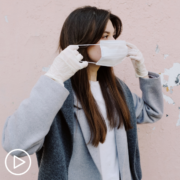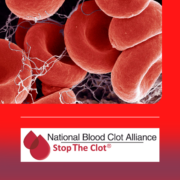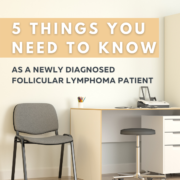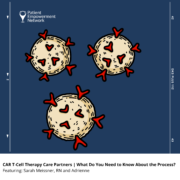CLL Treatment Advances: What Do You Need to Know?
CLL Treatment Advances: What Do You Need to Know? from Patient Empowerment Network on Vimeo.
Dr. Matthew Davids reviews promising chronic lymphocytic leukemia (CLL) research and shares online resources for patients to stay informed as treatments develop.
Dr. Matthew Davids is the Associate Director of the CLL Center at Dana-Farber Cancer Institute. More about this expert.
See More From The Path to CLL Empowerment
Related Resources

|

CLL Genetic Tests: How Do Results Impact Treatment and Care? |

|
Transcript:
Dr. Matthew Davids
So, this remains a very exciting time for CLL research. The last several years have witnessed the development of a number of these novel agent-based approaches, these oral drugs that target the different pathways inside the CLL cell that the cell survives with.
And so, we’ve really kind of reached the end of the beginning, as I call it, because the first goal, of course, was developing each one of these novel agent drugs on its own. We had to show first that they were safe and figure out what the dose was for patients, and then figure out that they’re effective on their own. And we’ve kind of checked those boxes at this point and reached a point where we have now several different novel agents that are FDA approved already for CLL patients.
And so, I think the big research challenge now going forward is kind of twofold. One is identifying the best combinations of these drugs to put together. And No. 2, identifying which patients will benefit most from which specific combinations.
And so, there’s a number of different clinical trials going on right now looking at these questions.
And just kind of highlighting some of them, one of them is the study of venetoclax with obinutuzumab that I mentioned before. We just had a pretty early readout from this study. But I think it’s gonna be very important to see how patients do over time after they finish the one year of therapy, and both for this study as well as another study called MURANO, which looked at the patients who had already had prior chemotherapy-based regimens and then received venetoclax, in this case with rituximab.
In both cases, when there’s time-limited therapy, I think a key research question is gonna be, when those patients do have progression of the CLL – hopefully years later – do they respond again to that same treatment? Can you use venetoclax again? And do the patients respond nicely? And if they do, then that could be a very nice intermittent treatment strategy to allow patients to be off therapy for a period of time, and then only to receive additional treatment when they need it.
I think another important and exciting area is the combination approaches. And I’ve talked about both ibrutinib and venetoclax as probably two of our most promising new drugs. And so, there are now a number of different studies exploring the combination of ibrutinib plus venetoclax given at the same time. And some of the initial data that’s been published looks very promising. This is a very well tolerated and highly effective combination in the initial studies. It’s all oral, which is nice. So, it’s just pills without the need for any infusions. And again, it’s designed to, hopefully, be a time-limited regimen, and patients hopefully will have a nice durable response after an initial treatment with these two drugs.
There are certainly a number of other drugs that are very promising as well. There’s a whole class that we haven’t talked about yet called PI3 kinase inhibitor drugs. We have two such drugs currently approved now for CLL patients, idelalisib and duvelisib. These drugs also are very effective for treating CLL but tend to have more side effects when they’re given as the first therapy. So, most patients will start with a different therapy. But then the PI3 kinase drugs can be a great option for patients who are in the relapse setting after they’ve had prior treatments.
And there’s another one in development called umbralisib, which also looks very promising and seems to perhaps be even the safest of these PI3 kinase inhibitor drugs. And that’s not yet FDA approved. But we anticipate it’s likely gonna get an approval relatively soon.
And so, combining these new PI3 kinase drugs also with venetoclax is an area of research interest, and a number of other combinations. As you can imagine, the longer the list grows of drugs, the more different combinations we can explore. And we’re trying to use the science from the laboratory to try to determine ahead of time what we think are the most promising strategies because we can’t do clinical trials of every single combination. But those are some of the sort of novel agent studies that I’m excited about right now.
I think the other area that could prove to be very helpful for our CLL patients is CAR T-cell therapy, which stands for chimeric antigen receptor T-cells. CAR T-cell therapy is a way to harness the body’s own immune system to fight cancer.
So, to do this, we would take cells out from a patient. And these are T lymphocyte cells. So, not the CLL cells, but a normal immune cell called a T lymphocyte. And then the cells get educated outside the body to recognize CLL cells more effectively. And they’re grown up and expanded and then reinfused into a patient, where they can go around and kill CLL cells. This can be a very effective treatment and can lead to complete remissions with durability.
And this approach is now in clinical trials. There are some risks to CAR T-cell based therapy. Something called cytokine release syndrome, where patients can get very sick, almost like they have a severe infection, but they don’t have an infection. There’s some neurologic risks to this as well that can be quite scary if they happen but in almost all cases are reversible. So, I think that this is an interesting area of research right now. It’s certainly not yet approved by the FDA for CLL. But we hope that, over time, as the CAR T-cell therapy becomes more effective and has fewer side effects, that eventually it will become a therapy option for patients who have had prior treatments for their CLL.
So, I think despite the fact that we’ve made a lot of advances in the last few years, we still have a lot of work to do in the research area to try to improve our treatments even further for our CLL patients.
So, in terms of how patients can stay informed about all these developments, it frankly is quite challenging, even for us in the field, to keep up with all of this. But there are some resources that can help. The first thing I would say is that the research tends to come along in fits and spurts, and one of the fits is generally the big research meetings where we all gather together to present our new data.
And probably the biggest highlight of the year is the ASH meeting, American Society of Hematology, which is usually in early December. That’s a good time to start looking on the internet for news about CLL, latest treatments, those sorts of things. Often, it’s kind of early December where we first hear about these breaking stories.
Another meeting that’s become big over the last few years is the European Hematology Association, which usually takes place in mid-June. And that’s, again, another time when we often see new data coming about. And one area where I would say this could be very helpful – or one website that I think is helpful – is the CLL Society website. This is led by Brian Koffman, who himself is a CLL patient.
And he kind of collates a lot of the information from these meetings and puts them in one place on his website. He’ll often interview CLL specialists to get their opinion about some of the newest developments. And so, I think Brian’s webpage, CLLSociety.org, can really be a great resource for getting up to date on the latest data.
There certainly are other websites out there now as well which are helpful. For example, another one that I’m working with closely is called VJHemOnc. And VJHemOnc comes to these big meetings, again, interviews a lot of the experts on their takes on the new data.
And I find that this platform in particular, the video-based platform, can be very engaging. It really forces us, as the investigators, to kind of hone down on what the most important key points are and give little snippets about that. And I would think that would be easier for our patients, in many cases, to digest, compared to some of the original papers themselves, which can be quite dense.
So, those would be my major resources that I’d recommend for CLL patients who are looking for additional information on the latest research.










